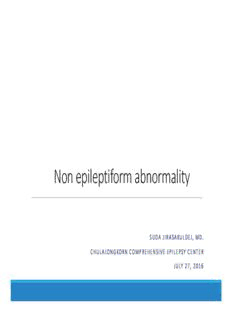
Non epileptiform abnormality PDF
Preview Non epileptiform abnormality
Non epileptiform abnormality SUDA JIRASAKULDEJ, MD. CHULALONGKORN COMPREHENSIVE EPILEPSY CENTER JULY 27, 2016 Outline •Slow pattern •Amplitude asymmetry • Focal slowing •Focal attenuation • Generalized or regional slowing •Generalized change of amplitude • Triphasic waves • Low voltage and suppressed patterns •Fast frequency pattern • Generalized suppression • Abnormal beta activity • Burst suppression • Breach rhythm • Electro-cerebral inactivity • High voltage pattern •Patterns in coma ◦ Alpha coma •Abnormal frequency or reactivity of alpha ◦ Alpha-theta coma •Abnormal sleep potentials ◦ Beta coma ◦ Spindle coma Abnormal EEG pattern •Interictal epileptiform activity •Ictal patterns •Non-epileptiform abnormality Slow pattern Focal slowing Generalized slowing Triphasic waves Focal slowing •Frequency less than 8 Hz and limited distribution •Delta 0.5-3.9 Hz, theta 4-7.9 Hz •Indicate focal cerebral dysfunction •Result of cortex deafferentation from subcortical structure •Suggests underlying abnormality but nonspecific etiology ◦ Structural (tumor, infarction, trauma, abscess) ◦ Functional (postictal, migraine) ◦ Rarely: toxic-metabolic: hypoglycemia, hyperglycemia Focal slowing: assessment •Arrhythmic polymorphic or rhythmic monomorphic •Persistence: intermittent or continuous •Reactivity •Amplitude •Frequency Focal slowing: clinical correlation •Continuous focal arrhythmic polymorphic delta activity • Highly correlated with localized structural lesion in subcortical white matter • Tumor, stroke, abscess, intra parenchymal hematoma or contusion •Continuous focal rhythmic monomorphic slowing • More commonly associated with grey matter lesions •Persistence Indicators of damage degree •Reactivity •Frequency •Slow growing tumor usually associated with focal slow more frequently in theta range +/- epileptiform discharges •Fast-growing tumor focal slow in delta range Generalized or regional slow Generalized or regional slow •Intermittent or continuous •Arrhythmic polymorphic or rhythmic monomorphic •Synchronous or asynchronous • Synchronous disordered circuits between cortex and thalamus • Asynchronous interfere with structural or function of both hemispheres, and involve subcortical white matter or thalamocortical or corticothalamic pathway Intermittent rhythmic delta activity (IRDA) •Runs of high voltage rhythmic 2-3 Hz recurring at irregular interval •Bisynchronous, monomorphic, may be asymmetric or unilateral, reactive/attenuate to eye opening or alerting •Considered a projected rhythm from deep structure, may reflect diffuse grey dysfunction either cortical or subcortical •Possible sources in reticular activating system or dorsomedial nucleus of thalamus
Description: